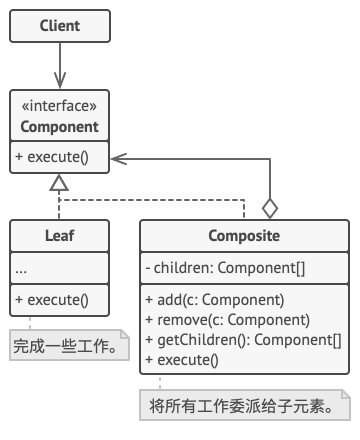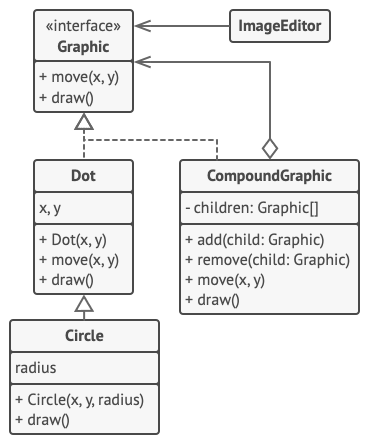亦称: 对象树、Object Tree、Composite
意图
组合模式是一种结构型设计模式, 你可以使用它将对象组合成树状结构, 并且能像使用独立对象一样使用它们

问题
如果应用的核心模型能用树状结构表示, 在应用中使用组合模式才有价值。
例如, 你有两类对象: 产品和 盒子 。 一个盒子中可以包含多个 产品或者几个较小的 盒子 。 这些小 盒子中同样可以包含一些 产品或更小的 盒子 , 以此类推。
假设你希望在这些类的基础上开发一个定购系统。 订单中可以包含无包装的简单产品, 也可以包含装满产品的盒子…… 以及其他盒子。 此时你会如何计算每张订单的总价格呢?

订单中可能包括各种产品, 这些产品放置在盒子中, 然后又被放入一层又一层更大的盒子中。 整个结构看上去像是一棵倒过来的树。
你可以尝试直接计算: 打开所有盒子, 找到每件产品, 然后计算总价。 这在真实世界中或许可行, 但在程序中, 你并不能简单地使用循环语句来完成该工作。 你必须事先知道所有 产品和 盒子的类别, 所有盒子的嵌套层数以及其他繁杂的细节信息。 因此, 直接计算极不方便, 甚至完全不可行。
解决方案
组合模式建议使用一个通用接口来与 产品和 盒子进行交互, 并且在该接口中声明一个计算总价的方法。
那么方法该如何设计呢? 对于一个产品, 该方法直接返回其价格; 对于一个盒子, 该方法遍历盒子中的所有项目, 询问每个项目的价格, 然后返回该盒子的总价格。 如果其中某个项目是小一号的盒子, 那么当前盒子也会遍历其中的所有项目, 以此类推, 直到计算出所有内部组成部分的价格。 你甚至可以在盒子的最终价格中增加额外费用, 作为该盒子的包装费用。

组合模式以递归方式处理对象树中的所有项目
该方式的最大优点在于你无需了解构成树状结构的对象的具体类。 你也无需了解对象是简单的产品还是复杂的盒子。 你只需调用通用接口以相同的方式对其进行处理即可。 当你调用该方法后, 对象会将请求沿着树结构传递下去。
真实世界类比

部队结构的例子。
大部分国家的军队都采用层次结构管理。 每支部队包括几个师, 师由旅构成, 旅由团构成, 团可以继续划分为排。 最后, 每个排由一小队实实在在的士兵组成。 军事命令由最高层下达, 通过每个层级传递, 直到每位士兵都知道自己应该服从的命令。
组合模式结构

-
组件 (Component) 接口描述了树中简单项目和复杂项目所共有的操作。
-
叶节点 (Leaf) 是树的基本结构, 它不包含子项目。
一般情况下, 叶节点最终会完成大部分的实际工作, 因为它们无法将工作指派给其他部分。
-
容器 (Container)——又名 “组合 (Composite)”——是包含叶节点或其他容器等子项目的单位。 容器不知道其子项目所属的具体类, 它只通过通用的组件接口与其子项目交互。
容器接收到请求后会将工作分配给自己的子项目, 处理中间结果, 然后将最终结果返回给客户端。
-
客户端 (Client) 通过组件接口与所有项目交互。 因此, 客户端能以相同方式与树状结构中的简单或复杂项目交互。
伪代码
在本例中, 我们将借助组合模式帮助你在图形编辑器中实现一系列的几何图形。

几何形状编辑器示例。
组合图形CompoundGraphic是一个容器, 它可以由多个包括容器在内的子图形构成。 组合图形与简单图形拥有相同的方法。 但是, 组合图形自身并不完成具体工作, 而是将请求递归地传递给自己的子项目, 然后 “汇总” 结果。
通过所有图形类所共有的接口, 客户端代码可以与所有图形互动。 因此, 客户端不知道与其交互的是简单图形还是组合图形。 客户端可以与非常复杂的对象结构进行交互, 而无需与组成该结构的实体类紧密耦合。
// 组件接口会声明组合中简单和复杂对象的通用操作。
interface Graphic ismethod move(x, y)method draw()// 叶节点类代表组合的终端对象。叶节点对象中不能包含任何子对象。叶节点对象
// 通常会完成实际的工作,组合对象则仅会将工作委派给自己的子部件。
class Dot implements Graphic isfield x, yconstructor Dot(x, y) { …… }method move(x, y) isthis.x += x, this.y += ymethod draw() is// 在坐标位置(X,Y)处绘制一个点。// 所有组件类都可以扩展其他组件。
class Circle extends Dot isfield radiusconstructor Circle(x, y, radius) { …… }method draw() is// 在坐标位置(X,Y)处绘制一个半径为 R 的圆。// 组合类表示可能包含子项目的复杂组件。组合对象通常会将实际工作委派给子项
// 目,然后“汇总”结果。
class CompoundGraphic implements Graphic isfield children: array of Graphic// 组合对象可在其项目列表中添加或移除其他组件(简单的或复杂的皆可)。method add(child: Graphic) is// 在子项目数组中添加一个子项目。method remove(child: Graphic) is// 从子项目数组中移除一个子项目。method move(x, y) isforeach (child in children) dochild.move(x, y)// 组合会以特定的方式执行其主要逻辑。它会递归遍历所有子项目,并收集和// 汇总其结果。由于组合的子项目也会将调用传递给自己的子项目,以此类推,// 最后组合将会完成整个对象树的遍历工作。method draw() is// 1. 对于每个子部件:// - 绘制该部件。// - 更新边框坐标。// 2. 根据边框坐标绘制一个虚线长方形。// 客户端代码会通过基础接口与所有组件进行交互。这样一来,客户端代码便可同
// 时支持简单叶节点组件和复杂组件。
class ImageEditor isfield all: CompoundGraphicmethod load() isall = new CompoundGraphic()all.add(new Dot(1, 2))all.add(new Circle(5, 3, 10))// ……// 将所需组件组合为复杂的组合组件。method groupSelected(components: array of Graphic) isgroup = new CompoundGraphic()foreach (component in components) dogroup.add(component)all.remove(component)all.add(group)// 所有组件都将被绘制。all.draw()组合模式适合应用场景
如果你需要实现树状对象结构, 可以使用组合模式。
组合模式为你提供了两种共享公共接口的基本元素类型: 简单叶节点和复杂容器。 容器中可以包含叶节点和其他容器。 这使得你可以构建树状嵌套递归对象结构。
如果你希望客户端代码以相同方式处理简单和复杂元素, 可以使用该模式。
组合模式中定义的所有元素共用同一个接口。 在这一接口的帮助下, 客户端不必在意其所使用的对象的具体类。
实现方式
-
确保应用的核心模型能够以树状结构表示。 尝试将其分解为简单元素和容器。 记住, 容器必须能够同时包含简单元素和其他容器。
-
声明组件接口及其一系列方法, 这些方法对简单和复杂元素都有意义。
-
创建一个叶节点类表示简单元素。 程序中可以有多个不同的叶节点类。
-
创建一个容器类表示复杂元素。 在该类中, 创建一个数组成员变量来存储对于其子元素的引用。 该数组必须能够同时保存叶节点和容器, 因此请确保将其声明为组合接口类型。
实现组件接口方法时, 记住容器应该将大部分工作交给其子元素来完成。
-
最后, 在容器中定义添加和删除子元素的方法。
记住, 这些操作可在组件接口中声明。 这将会违反接口隔离原则, 因为叶节点类中的这些方法为空。 但是, 这可以让客户端无差别地访问所有元素, 即使是组成树状结构的元素。
组合模式优缺点
- 你可以利用多态和递归机制更方便地使用复杂树结构。
- 开闭原则。 无需更改现有代码, 你就可以在应用中添加新元素, 使其成为对象树的一部分。
- 对于功能差异较大的类, 提供公共接口或许会有困难。 在特定情况下, 你需要过度一般化组件接口, 使其变得令人难以理解。
与其他模式的关系
-
桥接模式、 状态模式和策略模式 (在某种程度上包括适配器模式) 模式的接口非常相似。 实际上, 它们都基于组合模式——即将工作委派给其他对象, 不过也各自解决了不同的问题。 模式并不只是以特定方式组织代码的配方, 你还可以使用它们来和其他开发者讨论模式所解决的问题。
-
你可以在创建复杂组合树时使用生成器模式, 因为这可使其构造步骤以递归的方式运行。
-
责任链模式通常和组合模式结合使用。 在这种情况下, 叶组件接收到请求后, 可以将请求沿包含全体父组件的链一直传递至对象树的底部。
-
你可以使用迭代器模式来遍历组合树。
-
你可以使用访问者模式对整个组合树执行操作。
-
你可以使用享元模式实现组合树的共享叶节点以节省内存。
-
组合和装饰模式的结构图很相似, 因为两者都依赖递归组合来组织无限数量的对象。 装饰类似于组合, 但其只有一个子组件。 此外还有一个明显不同: 装饰为被封装对象添加了额外的职责, 组合仅对其子节点的结果进行了 “求和”。 但是, 模式也可以相互合作: 你可以使用装饰来扩展组合树中特定对象的行为。
-
大量使用组合和装饰的设计通常可从对于原型模式的使用中获益。 你可以通过该模式来复制复杂结构, 而非从零开始重新构造。
代码示例
#include <algorithm>
#include <iostream>
#include <list>
#include <string>
/*** The base Component class declares common operations for both simple and* complex objects of a composition.*/
class Component {/*** @var Component*/protected:Component *parent_;/*** Optionally, the base Component can declare an interface for setting and* accessing a parent of the component in a tree structure. It can also* provide some default implementation for these methods.*/public:virtual ~Component() {}void SetParent(Component *parent) {this->parent_ = parent;}Component *GetParent() const {return this->parent_;}/*** In some cases, it would be beneficial to define the child-management* operations right in the base Component class. This way, you won't need to* expose any concrete component classes to the client code, even during the* object tree assembly. The downside is that these methods will be empty for* the leaf-level components.*/virtual void Add(Component *component) {}virtual void Remove(Component *component) {}/*** You can provide a method that lets the client code figure out whether a* component can bear children.*/virtual bool IsComposite() const {return false;}/*** The base Component may implement some default behavior or leave it to* concrete classes (by declaring the method containing the behavior as* "abstract").*/virtual std::string Operation() const = 0;
};
/*** The Leaf class represents the end objects of a composition. A leaf can't have* any children.** Usually, it's the Leaf objects that do the actual work, whereas Composite* objects only delegate to their sub-components.*/
class Leaf : public Component {public:std::string Operation() const override {return "Leaf";}
};
/*** The Composite class represents the complex components that may have children.* Usually, the Composite objects delegate the actual work to their children and* then "sum-up" the result.*/
class Composite : public Component {/*** @var \SplObjectStorage*/protected:std::list<Component *> children_;public:/*** A composite object can add or remove other components (both simple or* complex) to or from its child list.*/void Add(Component *component) override {this->children_.push_back(component);component->SetParent(this);}/*** Have in mind that this method removes the pointer to the list but doesn't* frees the* memory, you should do it manually or better use smart pointers.*/void Remove(Component *component) override {children_.remove(component);component->SetParent(nullptr);}bool IsComposite() const override {return true;}/*** The Composite executes its primary logic in a particular way. It traverses* recursively through all its children, collecting and summing their results.* Since the composite's children pass these calls to their children and so* forth, the whole object tree is traversed as a result.*/std::string Operation() const override {std::string result;for (const Component *c : children_) {if (c == children_.back()) {result += c->Operation();} else {result += c->Operation() + "+";}}return "Branch(" + result + ")";}
};
/*** The client code works with all of the components via the base interface.*/
void ClientCode(Component *component) {// ...std::cout << "RESULT: " << component->Operation();// ...
}/*** Thanks to the fact that the child-management operations are declared in the* base Component class, the client code can work with any component, simple or* complex, without depending on their concrete classes.*/
void ClientCode2(Component *component1, Component *component2) {// ...if (component1->IsComposite()) {component1->Add(component2);}std::cout << "RESULT: " << component1->Operation();// ...
}/*** This way the client code can support the simple leaf components...*/int main() {Component *simple = new Leaf;std::cout << "Client: I've got a simple component:\n";ClientCode(simple);std::cout << "\n\n";/*** ...as well as the complex composites.*/Component *tree = new Composite;Component *branch1 = new Composite;Component *leaf_1 = new Leaf;Component *leaf_2 = new Leaf;Component *leaf_3 = new Leaf;branch1->Add(leaf_1);branch1->Add(leaf_2);Component *branch2 = new Composite;branch2->Add(leaf_3);tree->Add(branch1);tree->Add(branch2);std::cout << "Client: Now I've got a composite tree:\n";ClientCode(tree);std::cout << "\n\n";std::cout << "Client: I don't need to check the components classes even when managing the tree:\n";ClientCode2(tree, simple);std::cout << "\n";delete simple;delete tree;delete branch1;delete branch2;delete leaf_1;delete leaf_2;delete leaf_3;return 0;
}执行结果
Client: I've got a simple component: RESULT: LeafClient: Now I've got a composite tree: RESULT: Branch(Branch(Leaf+Leaf)+Branch(Leaf))Client: I don't need to check the components classes even when managing the tree: RESULT: Branch(Branch(Leaf+Leaf)+Branch(Leaf)+Leaf)






)


![[C/C++]数据结构 希尔排序](http://pic.xiahunao.cn/[C/C++]数据结构 希尔排序)

)
)






